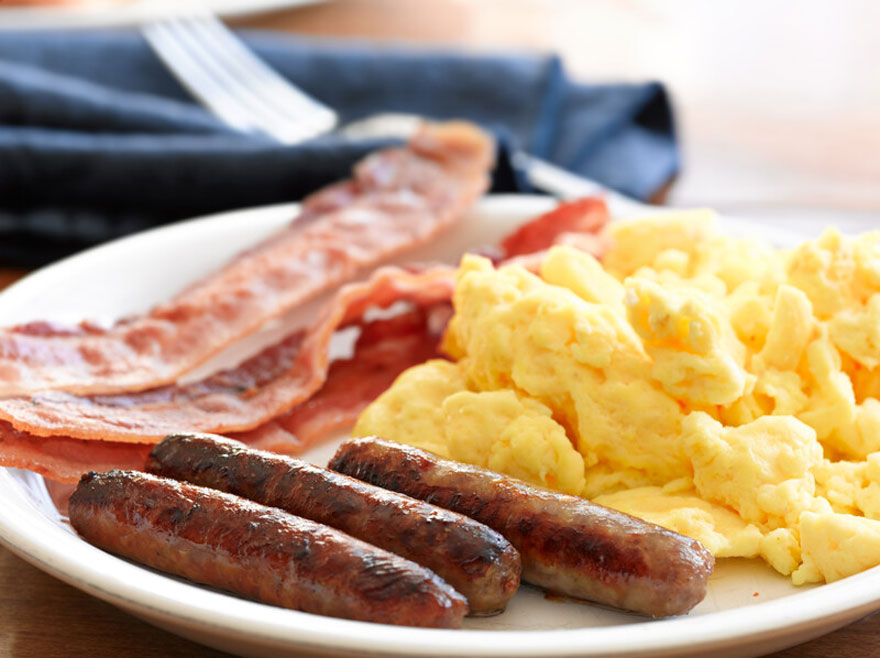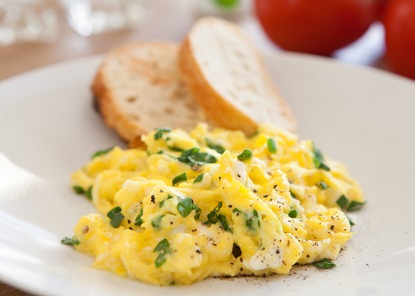Do you love fluffy scrambled eggs? Follow along as we show you how to make the best scrambled eggs with some helpful tips.

How to Make Perfect Fluffy Scrambled Eggs
Scrambled eggs are one of those menu options that everyone tends to take for granted – until they are asked to prepare it. However, this is in fact one of the quickest and easiest meals to whip up, regardless of whether you are cooking for 2 or a horde of hungry teenagers.
Eggs are delicious for breakfast, lunch or dinner and are a healthy choice to start the day. Don’t just buy any eggs in the grocery store, read more about how to choose the best eggs before you buy your next carton of eggs.
Below are some handy tips to help ensure that your scrambled eggs turn out perfectly every time.
Gather Your Ingredients for Scrambled Eggs:
- Fresh Eggs – organic if possible
- Butter or Olive Oil
- Salt & Pepper

STEPS TO MAKE THE BEST SCRAMBLED EGGS
Step #1 – Gather the Eggs
The number of eggs you will need will depend on how many people you are going to be cooking for and the size of the eggs you are going to be using. If your eggs are medium or large, allow for 2 to 3 eggs per person. However, if you are using extra-large, jumbo or super jumbo-sized eggs, 1 to 2 eggs per person will usually suffice, especially if they are being served with toast, fruit or other dishes.
Step #2 – Crack Eggs into a Jug or Measuring Cup
Have 2 smaller cups and a large measuring jug on hand when cracking your eggs, as this will save you from having to throw away a few good eggs if you happen to come across a bad one. Crack each egg into one of the cups so that you can determine if it is fresh or not. Afterwards, transfer it into the large jug and repeat with your other eggs. If you happen to come across 1 bad egg, it can be kept in the smaller cup until you discard it. Once all the eggs are in the jug, they can be beaten or whisked to combine them.
Step #3 – Pre-heat your Frying Pan
Add a little butter, margarine, olive oil or any other oil that you usually cook with and pre-heat your frying pan – low to medium heat will do. Allow the butter to melt slowly or the oil to warm and then pour the egg mixture from the jug into the frying pan. Be sure to stir the eggs slowly with a wooden spoon or silicone spatula, as this will ensure that you are able to reach all the edges of the pan and cook the egg evenly throughout.
Step #4 – Remove before Thoroughly Cooked
Scrambled eggs will continue cooking for a short while in the pan after turning off the stove heat, so it is important to remove them from the stovetop while they are still a little runny. This will prevent them from being overcooked, turning brown and becoming too dry or powdery to enjoy.
When served with lightly buttered bread or toast, scrambled eggs can in fact be a complete – and extremely affordable meal. If you’d like a little something different, they can be cooked with pieces of chopped bacon, peppers, chives or finely chopped herbs of your choice. However, if you’re looking at creating a really delectable treat, consider adding 1 teaspoon of cream for each egg in your pan and your eggs will turn out more delectable than ever.

Delicious Additions to Scrambled Eggs
- Sauteed Vegetables – Mushrooms, Peppers, Zucchini, Onion – Before adding the eggs, sauté chopped fresh vegetables in butter and oil for about 5 minutes or until tender.
- Cream Cheese
- Cheddar Cheese
- Fresh Chives
- Sausage
- Chopped Zucchini
- Spinach
- Avocado
- Tomatoes
- Salsa
What to Serve with Scrambled Eggs:
Sausage or Bacon
Hash Browns
Fresh Fruit
Fried Potatoes
Ham Slices
Baked Beans
Buttered Toast

Our Top Tips for Fluffy Scrambled Eggs Every Time:
To achieve the perfect fluffy texture for your scrambled eggs, follow these top tips:
Always Use Fresh Eggs – Fresh eggs have thicker whites, which help create a better structure when scrambled. Check the expiration date on the carton to ensure they’re fresh.
Whisk Vigorously – Use a whisk or fork to beat the eggs thoroughly. Whisking adds air to the mixture, resulting in fluffier eggs. Don’t be afraid to incorporate a lot of air into the eggs.
Always Add a Splash of Liquid – For extra fluffiness, add a small splash of milk, cream, or water to the eggs before whisking. This helps to create steam during cooking, which contributes to the airy texture.
Season Well – Before cooking, season the eggs with salt and pepper to taste. Adding the seasoning in advance allows it to distribute evenly throughout the eggs.
Use Medium-Low Heat – Cooking scrambled eggs over low to medium-low heat prevents them from becoming tough or overcooked. Cooking them slowly gives the proteins time to set without getting rubbery.
Use Butter – Instead of cooking spray or oil, use butter to grease the pan. The butter adds flavor and contributes to the velvety texture of the eggs.
Don’t Overcook – Cook the eggs just until they are set but still slightly moist. Remember that eggs continue to cook even after you turn off the heat, so it’s better to slightly undercook them in the pan.
Keep Stirring – Stir the eggs continuously while cooking, using a spatula or wooden spoon. Stirring gently prevents large curds from forming and ensures even cooking.
Remove from Heat Early – Take the eggs off the heat just before they reach your desired doneness. They will continue cooking from residual heat, and this helps avoid overcooking.
Serve Immediately – Scrambled eggs are best served right away while they are still hot and fluffy. Delayed serving may cause them to lose some of their fluffiness.
By following these tips, you’ll be able to enjoy deliciously fluffy scrambled eggs that are sure to impress anyone at the breakfast table!
Delicious Egg Recipes:
Eggs Over Hard
How to Cook Over Medium Fried Eggs
How to Make Dippy Eggs
Eggs in the Nest
– READ MORE ABOUT EGGS –
How to boil soft boiled or hard boiled eggs for beginner cooks
Why we Love Eggs – The Perfect Food
![]()